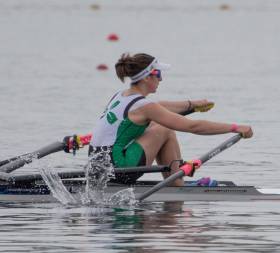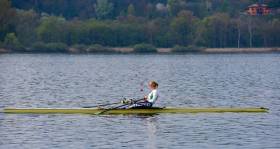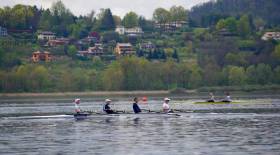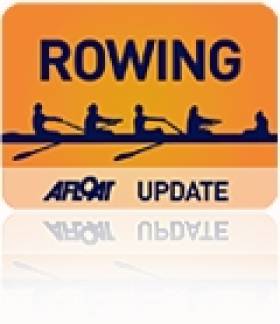Displaying items by tag: Jennings
#Rowing: Sinéad Lynch and Claire Lambe qualified for the semi-finals of the World Cup in Lucerne this morning with a fine performance in their heat. Drawn against World Champions Switzerland, Germany and Russia, and with just two places available, the Ireland lightweight double scull kept their heads and moved decisively in the third quarter to take the second spot behind winners New Zealand.
World Cup Regatta, Lucerne, Switzerland (Irish interest, selected results)
Women
Lightweight Double Sculls – Heats (Two to A/B Semi-Finals; rest to Repechage) – Heat One: 1 South Africa 6:57.90, 2 China Two 7:01.11. Heat Two: 1 Canada 6:56.56, 2 China One 6:57.98.
Heat Three: 1 New Zealand 7:00.16, 2 Ireland (C Lambe, S Lynch) 7:01.90; 3 Germany One 7:05.79, 4 Russia One 7:06.01, 5 Chile One.
#Rowing: Ireland had two fourth-place finishes in their first two A Finals of the European Rowing Championships in Brandenburg in Germany. The lightweight men’s pair of Mark O’Donovan and Shane O’Driscoll finished impressively to push Germany into fifth. Britain’s Sam Scrimgeour and Joel Cassells won, with Denmark second and Spain third. Lightweight single sculler Denise Walsh also had a good final quarter. Her race was dominated by Anja Noske of Germany, with Denmark and the Netherlands taking silver and bronze. Sinéad Jennings and Claire Lambe finished third in the B Final of the women’s lightweight double sculls, ninth overall. Sweden beat Britain into second, with Ireland over two seconds further back.
European Rowing Championships, Brandenburg, Germany – Day Three (Irish interest; selected results):
Men
Lightweight Pair – A Final: 1 Britain (S Scrimgeour, J Cassells) 7:00.38, 2 Denmark 7:03.94, 3 Spain 7:05.32; 4 Ireland (M O’Donovan, S O’Driscoll) 7:09.67
Women
Lightweight Double Sculls – B Final (Places 7 to 12): 1 Sweden 7:27.70, 2 Britain 7:27.99, 3 Ireland (C Lambe, S Jennings) 7:30.28.
Lightweight Single Sculls – A Final: 1 Germany (A Noske) 8:26.75, 2 Denmark 8:32.54, 3 Netherlands 8:37.05; 4 Ireland (D Walsh) 8:42.93.
#Rowing: Single sculler Sanita Puspure and the men’s lightweight double scull won their semi-finals to bring Ireland’s A Final tally to four at the European Rowing Championships in Brandenburg in Germany. The Ireland women’s lightweight double had to settle for a B Final place.
Paul O’Donovan and Gary O’Donovan produced an excellent finishing sprint to win their semi-final. Germany had led them down the course but the Cork brothers outpaced them in the dash to the line.
Puspure won a really good race, Nataliya Dovgodko of the Ukraine and and Lina Saltyte of Lithuania looked impressive in the first half in the tough, cross-headwind conditions, with Puspure also in the top three. Mirka Knapkova moved from fourth in the final seven hundred metres to dispute the lead, but Puspure finished strongly and kept her in second. Saltyte took third.
Sinéad Jennings and Claire Lambe finished fifth in their semi-final. Poland were impressive winners, with Denmark holding second for much of the race and Ireland disputing third with Romania. Britain pushed into the top four in the second half, but could not secure a top-three place. Romania pushed into second, ahead of Denmark. Britain finished fourth, one place ahead of Jennings and Lambe.
European Championships, Brandenburg, Germany – Day Two (Selected results, Irish interest)
Men
Lightweight Pair – Repechage (First Four to A Final; rest to B Final): 1 Denmark 7:26.63, 2 Ireland (M O’Donovan, S O’Driscoll) 7:27.99, 3 Germany 7:29.0, 4 Portugal 7:29.70.
Lightweight Double Sculls – Semi-Final One (First Three to A Final; rest to B Final): 1 Ireland (G O’Donovan, P O’Donovan) 7:00.52, 2 Germany 7:00.7, 3 Poland 7:08.37.
Women
Lightweight Double Sculls – Semi-Final Two (First Three to A Final; rest to B Final): 1 Poland 7:57.60, 2 Romania 8:01.47, 3 Denmark 8:03.45; 5 Ireland (C Lambe, S Jennings) 8:12.30
Single Sculls – Semi-Final One (First Three to A Final; rest to B Final): 1 Ireland (S Puspure) 8:44.67, 2 Czech Republic (M Knapkova) 8:45.61, 3 Lithuania (L Saltyte) 8:47.70.
Lightweight Single Sculls – Repechage (First Two to A Final; rest to B Final): 1 Ireland (D Walsh) 8:39.41, 2 Britain (I Walsh) 8:41.08.
O'Donovans Win Heat at European Championships
#Rowing: Gary and Paul O’Donovan won their heat of the lightweight double sculls at the European Championships in Brandenburg in Germany. The Czech Republic showed well early on, but by halfway the brothers from Skibbereen had a small lead, which they extended from there on. As the Czechs faded, Belgium strengthened, and they took second. Switzerland edged out the Czechs for the third direct qualification place.
Sinéad Jennings and Claire Lambe took second in their heat of the lightweight double to qualify for the semi-finals. With Ukraine stuck in fourth place, the Netherlands, Ireland and Germany were set for the semi-final places, but fought it out before finishing in that order.
Denise Walsh finished fifth in her heat of the lightweight single sculls and must compete in a repechage. In the men’s lightweight pair, the world champions, Sam Scrimgeour and Joel Cassells of Britain, won their heat and took the A Final place. The Ireland crew of Mark O’Donovan and Shane O’Driscoll held second right down the course and sprinted to the line to hold off a challenge by Poland.
European Championships, Brandenburg, Germany – Day One (Selected results, Irish interest)
Men
Lightweight Pair – Heat One (Winner to A Final; rest to repechage): 1 Britain (S Scrimgeour, J Cassells) 6:59.29; 2 Ireland (M O’Donovan, S O’Driscoll) 7:06.20.
Lightweight Double Sculls – Heat Two (First three to A/B Semi-Finals; rest to repechage): 1 Ireland (G O’Donovan, P O’Donovan) 6:46.75, 2 Belgium 6:49.46, 3 Switzerland 6:51.12.
Women
Quadruple Sculls – Heat One (Winner to A Final; rest to repechage): 3 Britain (3: H Nixon) 6:48.20.
Single Sculls – Heat One (First three to A/B Semi-Finals; rest to repechage): 1 Ireland (S Puspure) 8:09.55, 2 Latvia (E Gulbe) 8:13.73, 3 Britain (M Hodgkins-Byrne) 8:16.21.
Lightweight Double Sculls – Heat Three (First three to A/B Semi-Finals; rest to repechage): 1 Netherlands 7:29.38, 2 Ireland (C Lambe, S Jennings) 7:34.04, 3 Germany 7:38.89.
Lightweight Single Sculls – Heat One (First Two to A Final; rest to repechage): 1 Denmark 8:23.99, 2 Poland 8:25.82: 5 Ireland (D Walsh) 8:35.99.
Jennings and Lambe Bound for C Final at World Cup
#Rowing: The Ireland lightweight double of Sinéad Jennings and Claire Lambe finished fourth in their repechage and are bound for a C Final of the World Cup in Varese in Italy. Italy One and Italy Two battled it out at the head of the field, while Ireland lost a battle for the third qualification spot to Sweden.
The Ireland men’s lightweight four finished fifth in their repechage, rowed as conditions became tougher. The Ireland women’s pair of Leonora Kennedy and Barbara O’Brien also finished fifth in their repechage and also go to a C Final.
World Cup Regatta, Varese (Selected Results, Irish interest)
Men
Lightweight Four – Heat Three (First Two to A/B Semi-Final; rest to Repechages): 1 Italy Two 6:00.40, 2 United States 6:00.95; 4 Ireland (L Seaman, M O’Donovan, L Keane, S O’Driscoll) 6:18.75. Repechage One (First Three to A/B Semi-Finals; rest to C Final): Poland One 6:01.07, 2 Japan One 6:02.92, 3 Poland Two 6:03.41; 5 Ireland 6:14.13.
Lightweight Double Sculls – Heat Three (First Two to A/B Semi-Final; rest to Repechages): 1 Ireland (P O’Donovan, G O’Donovan) 6:27.07, 2 Britain 6:33.38; 3 Netherlands Two 6:48.24.
Women
Pair – Heat One (First Two to A/B Semi-Final; rest to Repechages): 1 Germany 7:23.08, 2 Russia One 7:24.46; 5 Ireland (L Kennedy, B O’Brien) 7:46.38. Repechage Two (First Three to Repechages; rest to C Final): 5 Ireland 7:24.68.
Lightweight Double Sculls – Heat Two (First Two to A/B Semi-Final; rest to Repechages): 1 Switzerland 7:03.98, 2 Canada 7:04.45; 3 Ireland (C Lambe, S Jennings) 7:05.0. Repechage One (First Three to A/B Semi-Finals; rest to C Final): 1 Italy One 6:57.42, 2 Italy Two 6:59.61, 3 Sweden One 7:01.20; 4 Ireland 7:05.60.
Single Sculls – Heat One (Winner to A/B Semi-Finals; rest to Repechages): 1 Ireland (S Puspure) 7:34.32; 2 Czech Republic (M Knapkova) 7:36.13.
Lightweight Single Sculls – Heat One (First Two to A/B Semi-Final; rest to Repechages): 1 Netherlands Two 7:40.25, 2 Italy 7:45.99; 4 Ireland Two (S McCrohan) 8:02.38.
Heat Two (First Two to A/B Semi-Final; rest to Repechages): 1 Canada 7:42.41, 2 Netherlands One 7:45.30; 5 Ireland One (D Walsh) 8:11.91.
O'Donovans Give Ireland Second Heat Win at World Cup Regatta
#Rowing: Ireland had its second heat win at the World Cup Regatta in Varese, as the lightweight double of Paul O’Donovan and Gary O’Donovan gave an excellent display. They took over the lead in the second half of the race and beat Britain into second place, with both crews qualifying for semi-finals.
Sinéad Jennings and Claire Lambe finished third in their heat, missing direct qualifcation for the semi-finals by just one spot. The Ireland lightweight double were very close to leaders Switzerland down the course, but in the drive for the line Canada took the second qualification place, with Ireland .55 of a second behind.
World Cup Regatta, Varese (Selected Results, Irish interest)
Men
Lightweight Double Sculls – Heat Three (First Two to A/B Semi-Final; rest to Repechages): 1 Ireland (P O’Donovan, G O’Donovan) 6:27.07, 2 Britain 6:33.38; 3 Netherlands Two 6:48.24.
Women
Pair – Heat One (First Two to A/B Semi-Final; rest to Repechages): 1 Germany 7:23.08, 2 Russia One 7:24.46; 5 Ireland (L Kennedy, B O’Brien) 7:46.38.
Lightweight Double Sculls – Heat Two (First Two to A/B Semi-Final; rest to Repechages): 1 Switzerland 7:03.98, 2 Canada 7:04.45; 3 Ireland (C Lambe, S Jennings) 7:05.0.
Single Sculls – Heat One (Winner to A/B Semi-Finals; rest to Repechages): 1 Ireland (S Puspure) 7:34.32; 2 Czech Republic (M Knapkova) 7:36.13.
Rio Olympians Sign Up for Irish Indoor Rowing Championships
#Rowing: The entry for the Irish Indoor Rowing Championships has both quantity and quality, with Irish rowers who are set to compete at the Olympic Games in the mix. Gary O’Donovan will compete in lightweight class and Paul O’Donovan in the under-23 lightweight class.
Claire Lambe, who partnered Sinéad Jennings in the Ireland lightweight women’s double crew which qualified the boat for Rio, is also entered. Jennings may do a Wattbike test.
Among the heavyweight men, Philip Doyle, Sam McKeown and Dave Neale will be among those competing to set the top mark, while Sanita Puspure, an Olympian in 2012, should be the fastest woman.
The Championships have a record entry and will be held in Limerick on January 23rd.
Afloat Rowers of the Year Announced
#Rowing: The Afloat Rowers of the Year for 2015 are the Ireland men’s and women’s lightweight double sculls who qualified their boats for the Olympic Games in 2016.
Claire Lambe and Sinéad Jennings needed to finish in the top 11 at the World Championships in Aiguebelette in August/September. They seemed well-placed in their semi-final to qualify for the A Final, but were pushed into fourth as Canada finished with a remarkable sprint. The Ireland crew changed tactics for the B Final, and it worked. They finished ninth.
The men’s lightweight double of Gary and Paul O’Donovan had a similar qualification mark in Aiguebelette. To have a shot they had to finish in the top three in their quarter-final, and they achieved this, pushing Hayden Cohen and Peter Taylor of New Zealand into fourth. They finished fifth in their semi-final and then booked their Rio place with a fifth-place finish (11th overall) in their B Final, eking out a place ahead of Greece, who had finished eighth at the Olympic Games in London.
Afloat wishes both crews and all the Irish rowing community the very best in 2016.
Rower of the Year Award: The judging panel is made up of Liam Gorman, rowing correspondent of The Irish Times and David O'Brien, Editor of Afloat magazine. Monthly awards for achievements during the year appeared on afloat.ie. The overall national award has been given to the crews who, in the judges' opinion, achieved the most notable results and made the most significant contribution to rowing during 2015. Keep an eye on progress in 2016.
Ireland Lightweight Doubles are Afloat Rowers of the Month
#Rowers of the Month: The Afloat Rowers of the Month for September are the Ireland men’s and women’s lightweight double sculls (Paul and Gary O’Donovan; Sinéad Jennings and Claire Lambe) which qualified their boats for the Olympic Games. Both crews faced challenges in their quest to be in the top 11 at the World Championships in Aiguebelette; both overcame them.
Jennings, a mother of three young children and a doctor, returned to the sport last year targeting a place in Rio. She broke a rib early this year. For another athlete this might have meant abandoning her punishing schedule. Jennings (then 38) redoubled her efforts. She excelled on the Wattbike at the Irish Indoor Championships and competed at the European Championships in a lightweight single. She came through a two-race trial to qualify for the lightweight double. Lambe and Jennings teamed up at the World Cup in Lucerne and finished seventh. It was a promising result, but this was their first time competing together. In the semi-final at the World Championships, they were outsprinted to the line by Canada, and missed out on an A Final spot. For the B Final, the tactics were to be in the leading group until the end. They did it. Their third place secured the precious slot in Rio for the Ireland women’s lightweight double.
Paul and Gary O’Donovan produced one of the greatest performances in Irish rowing by taking third place in their quarter final in Aiguebelette. With just a season of competition as a crew behind them, Gary (22) and Paul (21) were able to find a sprint finish which ousted New Zealand from a chance of qualifying their boat. In the B Final, the O’Donovan brothers stayed with the leaders until the finishing sprint, where they showed tremendous grit to take fifth (11th overall), .28 of a second ahead of Greece.
Well done to all the Ireland team and to the two crews which are the Afloat Rowers of the Month.
Rower of the Month awards: The judging panel is made up of Liam Gorman, rowing correspondent of The Irish Times and David O'Brien, Editor of Afloat magazine. Monthly awards for achievements during the year will appear on afloat.ie and the overall national award will be presented to the person or crew who, in the judges' opinion, achieved the most notable results in, or made the most significant contribution to rowing during 2015. Keep a monthly eye on progress and watch our 2015 champions list grow.
Two Ireland Boats Qualify for Olympic Games
#Rowing: Ireland qualified two boats for the Olympic Games at the World Rowing Championships in Aigubebelette in France. The lightweight men’s and women’s doubles had to finish in the top 11 to qualify, which meant a place in the top five of their B Finals.
The lightweight men’s crew of Paul and Gary O’Donovan took the final place. In a tense race, where the boats were tightly packed for much of the 2,000 metres, the O’Donovan’s sprinted to the line taking fifth just ahead of Greece – the margin was .28 of a second.
In the women’s race which followed, Ireland’s Sinead Jennings and Claire Lambe carved out a clear lead in the second quarter and held it until the pack caught them coming towards the line. However, the Irish were determined not to miss their chance, and took third behind China and Poland. This placed them ninth in the world.
World Rowing Championships, Aiguebelette, France – Day Seven (Irish interest)
Men
Lightweight Double Sculls – B Final (Places 7 to 12): 1 Poland 6:20.25, 2 United States 6:20.55, 3 Austria 6:22.04, 4 Switzerland 6:22.34, 5 Ireland (P O’Donovan, G O’Donovan) 6:23.20; 6 Greece 6:23.48.
Women
Lightweight Double Sculls – B Final (Places 7 to 12): 1 China 6:59.31, 2 Poland 7:00.37, 3 Ireland (C Lambe, S Jennings) 7:00.67, 4 Russia 7:00.79, 5 United States 7:02.21; 6 Sweden 7:02.45.


































































